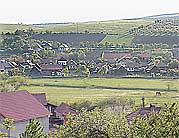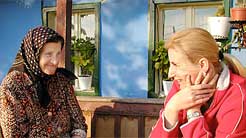Our Man in Romania
For almost two years Andy Trincia was ‘our man in Romania’ writing charming “Letters From . . .” for the Peace Corps Writers web site from 2002–04. He finished his tour, married his lovely HCN, and came back to the US, only to return again and again to his wife’s family’s village in the heart of Transylvania. Here is a lovely piece of prose that proves you can go home again to your Peace Corps site . . .
Going Home to Mama Ana’s Păuca

Pauca
Several peasants stopped working the fields and waved as we pulled into Păuca, a colorful Romanian village in the heart of Transylvania. Mama Ana’s “kids” were back from America, they noticed, eager to spread word across the little village faster than wild fire.
As picturesque as any of the scores of villages I’ve seen across the region, Păuca is a typical Romanian hamlet, inhabited by 300 or so hardy families who live off the land. Time seems to have stood still for more than a century, and the simple yet tough life is not unlike other corners of rural Europe, especially the former Eastern Bloc.
But this place is anything but typical for us, for it is where Mama Ana, my wife’s grandmother, was born and still lives, and where my mother-in-law was born and raised. My wife, Oana, spent summers playing there and is incredibly close to Mama Ana, a sweet-souled woman of 78 years whose head is always shrouded in a batic, or head scarf, a modesty common among older Romanian women, especially in the countryside.
As we entered the gate, several hens pecked away in the courtyard, right near the small pig pen and wooden outhouse. The house, built by Oana’s great-grandfather circa 1900, is a pretty brick structure painted in a blue-with-green-trim scheme found in the German-influenced villages that dot Transylvania, once part of the Austro-Hungarian Empire.

Mama Ana and Oana
Seeing Mama Ana and Oana embrace, shedding tears of joy, made the Easter time journey from our home in California worth every ounce of effort. I always enjoy visiting Păuca too, save for conducting business in the outhouse. I’m a city boy but a few days in the rustic environs puts things in perspective, be it chatting with the gentle, muddied locals as they head home from the fields on their horse-drawn carts, or Oana and me lugging a wagonload of drinking water from the village’s central well uphill to Mama Ana’s house (I can’t imagine doing it daily as she does). No stoplight here, but the town’s main road is paved, with the other side streets hardened with dusty gravel. Everybody knows everybody.
It was good to return to Romania, a country where I lived for more than three years this decade, including my Peace Corps service in Timişoara, a large university city, and later as an expatriate executive working in Bucharest, the bustling capital. Both are several hours away and light years ahead of Păuca.
During my Peace Corps service, I wrote home frequently about my experiences as a volunteer business educator and consultant. Sometimes I ranted about Romania’s bureaucratic headaches, corruption and mentality left over from Communism. Other times, I exulted because of small victories with helping students, special cross-cultural moments, or meaningful friendships, including the romance that blossomed with my Romanian girlfriend who is now my wife.
I always urge people to visit Romania, especially those who are patient travelers, have enough time off or at least a sense of off-the-beaten-path adventure (all not always applying to American tourists). The country hasn’t solidified its tourism promotion yet, but there are many worthwhile sights – castles, monasteries, mountains, beaches, museums and historical legacies from Communism and the liberating 1989 Revolution. Agro-tourism, in which tourists can experience village life, is thriving.
Romania is now — four years after I completed my Peace Corps service – and always will be part of my life. My wife’s entire family is there, along with our godparents and many friends. We own an apartment (and a car) near Oana’s parents, about two hours from Păuca, keeping a connection there that is important to Oana and her family, but it also makes a great base when we visit. Our small flat is furnished comfortably with belongings we shipped over from America during my expat stint, but it also has nice Romanian touches.
On our recent vacation, Romania still found a way to gnaw at times, a sort of love-hate relationship, though those words are too strong. I would say many Romanians feel the same way about their own country. It can in the same day, or even hour, be a wonderful, warm place, then it can drive you mad with frustration (for example, getting a new license plate — then again, American DMVs can be a pain . . .). But through it all, there’s just something about Romania. My wife and I jest that if you could only blend Romania and America because some things are better — and worse — in both countries.
Most rewarding is going back and seeing tangible progress. Stepping off the plane in Timişoara, I saw a huge banner ad showcasing the latest BlackBerry. I smiled when I saw the new European Union stamp in my passport, now that the country is a full EU member. The streets have more cars – some would say too many, at least in the cities – while cranes and construction equipment are visible across the urban landscape as new offices, apartment buildings and important infrastructure projects take hold.
It’s not all fun and games, however, as most people continue to struggle with rising cost of living and the same low salaries, despite EU accession. Corruption isn’t going away anytime soon. And while many young families have more disposable income, people are on an American-style, borrow-then-consume frenzy that could spell trouble down the road.
In places like Păuca, though, very little changes. Maybe that’s a good thing.
Andy Trincia lives in the Sacramento, Calif., area, where he is a vice president with a public affairs firm.
No comments yet.
Add your comment